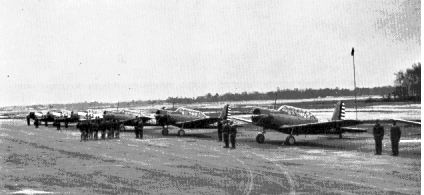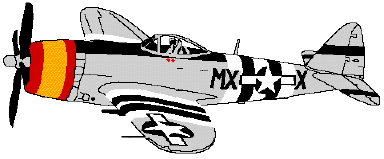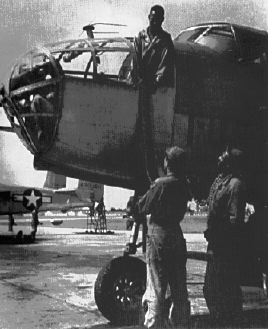
The Tuskegee Airmen trained on four main types of aircraft, which were similar to training aircraft flown by pilot trainees at other Army Air Corps training facilities. Among the aircraft flown by the pilots were the PT-17 Stearman, BT-13, AT-6 Texan and the P-40 War Hawk. The PT-17 was a bi-plane with fixed landing gear. The BT-13 and AT-6 were monoplanes. When the flying cadets mastered the skills learned in basic training they graduated to the P-40, a fighter that the graduates of the 99th would eventually use as their standard equipment.
The first class graduated from Tuskegee on March 7, 1942 and earned their wings. They were Lemuel Curtis, Charles DeBow, Mac Ross, George S. "Spanky" Roberts, and Benjamin O. Davis, Jr. Other classes soon followed and the Tuskegee Airmen flew into their place in history.

Photo of training aircraft, possibly BT-13's's at Tuskegee Army Air Field. USAF/Smithsonian
When the Tuskegee Airmen in the 99th Fighter Squadron arrived in North Africa, they flew the Curtiss P-40L War Hawk. The War Hawk was a familiar aircraft because they had flown it during their final training. The P-40 was an updated version of the fighter that the famed Flying Tigers flew in China against the Japanese prior to Pearl Harbor.
The P-40L had a top speed of 350 miles per hour and range of about 1,000 miles. It was armed with six fifty caliber Browning machine guns and could carry bombs and an external fuel tank. The P-40 was outclassed by some of the first line German fighters, notably the Me-109 and FW-190, which were faster and more manueverable. However, the P-40 was a rugged aircraft and pilots learned to utilize the strengths of their airplane.

When the men of the 332nd Fighter Group arrived in Taranto, Italy, they were initially assigned the task of coastal patrol flying an obsolete aircraft the Bell P-39 Airacobra. The Airacobra was slow compared to first line German and Italian fighters. Its main claim to fame was the 37mm cannon that fired through the propeller spinner. The P-39 was flown by other Allied pilots, especially the Russians who liked the cannon for ground attack missions. The men of the 332nd were fighter pilots and felt betrayed and frustrated. This feeling was underscored on March 17, 1944 Lieutenant Laurance D. Wilkins and Weldon K. Groves tried to intercept a German Ju-88 reconnaisance aircraft, which escaped with damage to its wing.
Note: A picture of the P-39 will be available at a future date.

There were several modifications to the P-51 which improved its performance and effectiveness. The P-51 models "A" and "B" was initially powered by an 1,150 hp Allison engine, but its performance was significantly improved when the British designed 1,590 hp Rolls-Royce Merlin engine was introduced in the "D" model making it one of the fastest American fighters capable of achieving the speed of 437 miles per hour. A bubble canopy, which allowed greater all around vision for the pilots, was introduced in the P-51D version. The early P-51's were armed with four fifty caliber Browning machine guns, however the P-51D and later variants were armed with six fifty caliber Browning MG53-2 machine guns. The Mustangs could be configured to carry bomb, rockets and external fuel tanks on external wing hardpoints. Range was increased from 450 miles (724 km) in the "A" model to 1,300 miles (2,092 km) in the "D" model when equipped with external fuel tanks.
Artist's approximation of a P-51 of the 100th Fighter Squadron, 332nd Fighter Group with the characteristic red tail assembly.
The men of the 332nd Group flew the P-51 with the following color scheme on their Mustang: Every airplane had red propeller spinners and red wing bands with all-red tail surfaces. Variations for each squadron included: the 99th had white trim tabs, the 100th used back on their trim tabs, the 301st used blue and the 302nd painted their yellow. In addition, the area aft of the propeller was painted with squadron colors: the 99th used a dark blue and white checkerboard, the 100th used solid red, the 301st painted theirs red and blue, while the 302nd used alternate red and yellow horizontal stripes. Each pilot painted slogans, names, pictures, caricatures, etc. based on his own preference.
Stanley Sandler on page 119 of his book,Segregated Skies: All-Black Combat Squadrons of WWII, "The 477th Bombardment Group was conceived solely in response to black pressure, rather than to any perception that black Americans in the Army Air Forces could make any great contribution to the war effort. And it remained a paper outfit from its activation in June 1943 until January 1944."
Author's note: Some sources call the 477th Bombardment Group the 477th Bombardment Group (Medium) and some sources list them as the 477th Bombardment Group (Negro).
By late 1944 the 477th was able to conduct combat training missions, but winter conditions reduced flying time. When not fighting weather and equipment, the men also faced racism from white officers and men. Promotions went mainly to the white officers and enlisted staff while black promotions were limited. In March, 1945 the 477th was moved to Freeman Field, Indiana. Tension between white and black personnel increased. Part of the problem of the 477th lay in its white base commander, Colonel Robert Selway whose strict segregationist policies hurt morale and led to the Freeman Field incident on April 5, 1944.
The 477th's contribution was not in its combat record. Ultimately the Freeman Field incident opened the door to the eventual desegregation of the USAAF. As Sandler notes on page 131, "The 477th, although lingering on as a unit until 1947, never saw combat. It scored no "kills", blasted no enemy positions, bombed no alien cities. But it had its victories."
The 477th Bombardment Group became the 477th Composite Group with B-25's and P-47's and trained for a possible role in the Pacific Theater. The war ended, however, before the 477th could be depoloyed overseas in a combat role.
The aircraft the 477th flew in training was the B-25 Mitchell medium bomber. This workhorse was used in both the European and Pacific Theaters. Variations of it included models with up to thirteen fifty caliber machine guns or a seventy-five (75 mm) cannon for anti-ship missions in the Pacific.

This is a picture of one of the B-25's of the 477th Group. Photo from USAF/Smithsonian Institute.
The main German fighters faced by the Tuskegee pilots were the:

Messerschmidt Me-109 Models "F" and "G". The Me-109G was powered by a 1,475 hp Daimler-Benz engine. It had a range of 435 miles (700 km) and a top speed of 400 miles per hour (640 km). It was armed with one 30mm MG FF cannon firing through the nose and two 13mm MG 131 machine guns firing through the propeller arc and two more 20mm MG151 cannons in the wings.
The Focke Wulf FW-190 was powered with a 1,700 hp BMW 801D eighteen cylinder radial engine. It was armed with two 13mm MG131 machine guns in the upper engine cowling and two 20mm MG151 cannons in the wings. It had a maximum speed of 419 miles per hour (675 km) and a range of 560 miles (900 km).
Messerschmidt Bf110, a twin engine fighter bomber that became a deadly radar equipped night fighter. The Me-110 was armed with four 20mm MG FF cannon in the nose and one 7.9mm MG 15 firing from a rear cockpit mount. It was capable of 349 miles per hour (562 km) and had a range of 680 miles (1,100 km)
Messerschmidt Me-262A, a twin jet powered fighter/fighter-bomber with a maximum speed of 540 miles per hour (870 km) and a range of 525 miles (845 km). It was armed with four 30mm MK 108 cannon in the nose. The Me-262 appeared in late 1944. No Allied fighter had the speed to meet the Me262 head-to-head although Allied pilots did down some of these early jet fighters.
Check out the other Logical thinker's web-site areas.
Newsletters | Social & Political Issues | Home | Hot links | History I poetry I Book spot Web-Rings
This site is maintained by Markus Rice updated 02/14/2000